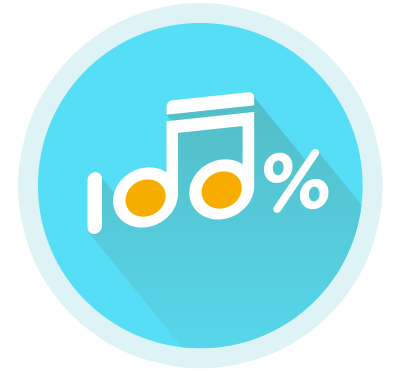Education through Music has a great compilation of studies available online.
Studies have shown that when students have arts
in the curriculum they are . . .
Statistics are sourced from Americans for the Arts
2x as likely to graduate than those who do not
3x more likely to win an award for school attendance
4x as likely to be recognized for academic achievement
Here are some intriguing facts from the NAMM Foundation:
DID YOU KNOW…?
 83% of teachers and 73% of parents do not see music education as a luxury, and believe that cuts to music programs are detrimental to student success.“Striking a Chord: The Public’s Hopes and Beliefs for K-12 Music Education in the United States 2015”
83% of teachers and 73% of parents do not see music education as a luxury, and believe that cuts to music programs are detrimental to student success.“Striking a Chord: The Public’s Hopes and Beliefs for K-12 Music Education in the United States 2015” According to Dr. Nina Kraus’s work with the Harmony Project, students who are involved in music are not only more likely to graduate high school, but also to attend college as well.Kraus N., Slater J., Thompson E.C., Hornickel J., Strait D.L., Nicol T. & White-Schwoch T. (2014), “Auditory learning through active engagement with sound: Biological impact
According to Dr. Nina Kraus’s work with the Harmony Project, students who are involved in music are not only more likely to graduate high school, but also to attend college as well.Kraus N., Slater J., Thompson E.C., Hornickel J., Strait D.L., Nicol T. & White-Schwoch T. (2014), “Auditory learning through active engagement with sound: Biological impact
- Students in high-quality school music programs score higher on standardized tests compared to students in schools with deficient music education programs, regardless of the socioeconomic level of the school or school district.Johnson, C. M. & Memmott, J. E. (2007). Examination of relationships between participation in school music programs of differing quality and standardized test results. Journal of Research in Music Education, 54(4), 293-307
- And in case that's not enough evidence to support the claim that music is an essential ingredient in our children's education, here are 20 more important benefits of music in our schools.
- So with all of this research out there, why is it even a possibility that schools would consider cutting back the arts and music programs in our schools? Well there are lots of reasons, the focus on STEM and core classes and test scores, the pressure to have kids "college-prepped" and "career-ready" from the time they are in elementary and middle school, limited funding and resources to accomplish federal, state and district requirements, and the list goes on.
- But with music being the ONE factor that improves student outcomes across even socio-economic boundaries, it should be the area we seek to build and support first, not the one that gets most readily pushed aside.
- This issue is a hot topic in my own school district right now, with additional state-mandated courses for middle schoolers requiring administrations to either increase the number of classes in their schedule or eliminate elective choices for students.
- At this point in time, it looks like our middle school students will either be able to take a World Language or an Arts elective but not both. And for students who are in a Dual Language Immersion program, English Language Learners, or those who need remedial help, there will be only one semester elective available out of all three years of middle school. This is just not an acceptable option for my students or for ANY students. We have got to place highest priority on preserving the arts programs in our schools.
- For our middle school right now, this almost certainly means going to a 7-period schedule even though it messes with teacher teams and prep times. I admire and respect middle school teachers above pretty much any profession out there. I don't want to require any more sacrifices of them than what they are currently giving, but I know that they are passionate about the success of our students, and the opportunity to take an arts elective HAS to be a part of that equation.
- Below is a copy of the letter I wrote to the school board and my state legislators about our own family's experience. If your school's arts programs are being threatened by the addition of more required classes by the state of Utah, I hope you will also take the time to write your school board and representatives to let them know how important it is to keep arts and music as a thriving part of our schools.
- To Canyons School Board, Superintendent and State Representatives,I and my 6th-grade Dual Immersion student are deeply concerned about the new required classes for 6th- and 8th-grade students, and the lack of options it leaves for middle school students who would like to pursue music and arts while continuing the DLI program. While I believe that adding more required classes will have a far-reaching effect on our students and our arts programs at the middle and high school levels, let me first give you some insight on what it will look like for our family.My son Cole is a hard-working, dedicated student who identifies himself as a Chinese-speaking, trombone-playing Math ninja. For unknown reasons (perhaps his duplicate record in Skyward from when we transferred to this school district), his Math scores did not come across when he moved from 5th grade at Draper Elementary to 6th grade at Draper Park Middle School. Because of this oversight, he did not get placed in the Honors Math class even though his scores were such that he should have qualified. He was sorely disappointed, and still is, that he has been placed on a "waiting list" to make it into Honors Math while other kids, including many of his friends, are able to participate. While I have been in contact with the school over this issue many times, the Honors classes are simply too full to allow even one more student to participate. And this is especially true because his team includes all the Chinese DLI students, who tend to be kids who take honors classes. So the Math portion of Cole's identity has taken a beating this year, but we are working to keep it intact.Probably the most exciting thing for a kid entering middle school is the chance to make a choice about what elective(s) they will take. The transition from elementary to middle school is a tough one: new friends, bigger school, more requirements from more teachers, many students, no more recess, etc. It is a lot to expect from an 11- or 12-year-old kid. So they pick an elective and find friends with similar interests. It helps them find some release from the other pressures of their daily routine, while providing valuable and enriching experiences that round out their education and build their identities. Band has been that piece of the puzzle for Cole. He loves playing an instrument, he loves the fun and engaging teaching style that Mr. Voght offers, and he loves the association with other kids who also enjoy learning music. He would be pretty devastated if he no longer had the choice to participate in Band. Also, making Band a before/after school only offering would be extremely difficult to maintain, not only for my child, but for so many others who are already over-involved and sleep-deprived. It is not really fair to expect more time commitment than what these kids are already giving. It is not realistic to expect our music programs to survive this kind of a blow. Cutting elective choices will be hard on students, music teachers, and music programs, even at the high school level - I don't think our middle school or high school will easily recover from this. If Cole has to drop music, there's another piece of his identity that gets displaced.From the first time we heard about the possibility of a Chinese dual immersion program at our elementary school, we worked and campaigned and rallied to get it to come to our school. Cole was a part of the inaugural year of DLI at Sage Creek Elementary in Springville, Utah. When our family came up against the need to move, we based our search for a new home on proximity to dual immersion schools because we were committed to continuing Cole's DLI experience. We ended up in Canyons School District, but not in the boundaries of either Lone Peak or Draper Elementary. We worked our way up the waiting list until we were accepted as out-of-boundary students to Draper Elementary. I have formed carpools or personally driven my two DLI students - first Cole, and now Sadie, my 2nd-grader - to and from Draper Elementary every day. Cole sees a Chinese tutor after school once a week, we have participated in Chinese summer camps and hosted Chinese foreign exchange students. We have fought for and are committed to making the most of our experience in the DLI program. I cannot abide the decision we are up against right now. Do we have to sacrifice every other fun part of Cole's education in order to continue to be a part of the DLI program? I do not want to require this of him. He should not have to choose between Band and Chinese. He should not have to sacrifice one more piece of his identity at this precarious time of life when we should be helping him to build that identity, not fracture it.I hope this gives you some insight into one student's experience, but his experience is not so different from other kids his age, and especially other DLI families. We are students and parents who are deeply invested in the education of our children. We are families who are willing to make sacrifices for future opportunities and for the benefit of our children. But our children should not be required to give up every other fun or exciting educational opportunity in the pursuit of one goal as is the case with our DLI kids right now. Even the non-DLI students will have to choose between taking a World Language or an arts elective. This is simply not an acceptable choice.From my perspective as a private music teacher, a parent, and someone who devoted all my university studies to discovering the links between music and learning, I absolutely believe, and there is plenty of research to back me up, that sacrificing arts electives is the last thing we want to do in order to improve the quality of education, student involvement and outcomes, and even the academics and test scores of our students.Please consider implementing the 7-period schedule at Draper Park Middle School in order to preserve our arts and music programs for current and future middle school students as well as high school students at Corner Canyon. Thank you for your consideration.Sincerely,Marianne BarrowesParent of one CCHS graduate, one CCHS choir student, and two Chinese DLI student musicians






